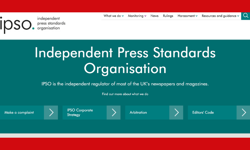A few years ago I attended my first ever Newspaper Sales & Promotions Conference run by the Newspaper Society. I attended as an exhibitor and looked forward to meeting lots of new people and discussing direct marketing opportunities during the time I was there, but what surprised me was how few people actually expressed any interest in these facilities. I looked at the list of visitors and it confirmed the presence of managing directors, circulation directors, marketing managers, editors, newspaper sales managers (frankly anyone who’s anyone in the regional press) and yet we met very few during the day. So we prepared for the evenings’ events and the chance to engage in some networking opportunities. That was certainly more rewarding, but what got me really thinking was the speech delivered by the keynote speaker. I became quite concerned when I heard the speaker tell the audience that a few years before he’d "been told that the internet would kill off the newspaper industry and here we were several years on and the presses were still turning – so much for the internet, long live the printed word!" It’s right to be passionate about the industry and of course the printed word is a very powerful tool (witness the longevity of the bible, the Declaration of Independence etc etc) but we have to be cautious of complacency (I say ‘we’ because I too believe in the power of the printed word having worked around printing presses for the past 20 years). It’s fine, of course, to rally the troops in the way the speaker did but we have to be careful we don’t allow ourselves to fall into this complacency trap. Ironically, just a few short years on from that speech, I’d guarantee that if I asked every circulation director now why their sales are in decline the internet would get a mention from most.
Decline in circulation isn’t exclusive to the regionals and is a culmination of several factors coming into play at the same time.
Logistics
Take logistics for example. We’ve all seen and read letters from readers to circulation departments cancelling long-term door to door delivery because of a failure to supply on a regular basis - you know the ones: "I’ve been a regular reader of the XYZ Herald for the past 15 years but I never seem to receive my copy regularly anymore." Then add the 2,000 retailers closing every year and clearly we can’t sit idly by. Remember Sainsbury’s recently documented logistical problems and how they lost significant footfall to the competition when supply was such an issue. We have to avoid disenfranchising our core readers before they break the habit.
How we promote
Then take a look at how we currently promote our papers - outbound telephone and door-to-door canvassing. Of course both have their place in our search for new readers but both also have limitations and possible negative connotations. Then there’s some limited direct mail but that tends to take the form of campaigns to known readers, namely participants in previous promotional games; but why promote to these individuals when we already know that they are regular readers? Surely, with regional newspapers finding it harder than ever to meet ABC targets, growth can only come from the people who we’re not currently speaking to, and when 10%-15% seems to be the norm for circulation let’s face it there’s a lot we can still be doing.
Data screening
In the newspaper industry we utilise outbound telephone techniques as the norm despite increasing resistance from the public following the increase in nuisance calls emanating from ‘random diallers’ or overseas call centres. This is reflected in the numbers of people adding their telephone numbers to the Telephone Preference Service (TPS), a suppression file that now contains over 9.0 million numbers. Also consider that BT’s ex-directory customers now stand at an incredible 50% of all their non-business registrations - that’s 11.5 million residential customers.
Then stop to consider how newsagents perceive their local newspaper. Do they see you as an ally as you court direct supply? Unlikely. But courting direct supply has to remain part of the process, otherwise aren’t we simply waiting for the inevitable?
Raise our game
Surely marketing, and more specifically direct marketing, has to be at the centre of our future plans. Why? Because most of the people you want to engage with now take the ‘local rag’ for granted. As consumers they’ve become complacent so now we have to raise our game if we are to avoid a continuing decline in circulation. We need to be more visible and that means a better weighting of our identity - ensure our messages differ from day to day with yesterday’s weakness becoming today’s strength. It’s consistency of brand exposure that’s required if we’re to be successful and direct mail and e-mail can be used effectively as mass marketing tools to achieve this; turning current thinking on its head.
We need to plant subconscious thoughts in our targets’ minds. Isn’t that why advertisers spend millions on TV advertising? They don’t expect us to see an advert for a new beverage and then rush off immediately to the shops; what they expect is that at some point, our trip to the shops and our recollection of their product will coincide and that we will then buy their product. We have to remind and re-engage our potential clients of our existence, to create awareness again.
Incidentally, let’s not forget some consumers will also be potential advertisers, so if we don’t create a lasting impression in our quest for new readers why should they turn to our media for advertising? Today’s consumers are bombarded with so many messages that if you don’t follow suit you simply won’t be considered. Isn’t this the reason why some retailers choose to freshen up an old image and then, as importantly, publicise that fact aggressively so as to see their sales soar again?
So, if we agree with the basic principle that we need to communicate who we are and that we need to provide a strong offer then our next step has to be eliminating any possible grievances from future targets. That involves data cleansing through MPS and TPS screening as well as deceased / gone-away screening. It’s rare, even in today’s society that tomorrow’s reader will register their details on both MPS and TPS registers. The numbers of people who are listed across both is not that great which in itself provides a clue as to how our ‘reader’ prefers us to communicate with him. The TPS list currently stands at 9.0 million, whereas the MPS holds only 2.3 million. So it would appear that the more accepted mechanism is generally mail over telephone, yet outbound calling forms such a key part in our initial approaches. In addition to data screening, data purity and, even more importantly, its suitability for purpose are essential factors. Marketing to old, out-dated or simply inappropriate lists will end in disappointment.
Role of discounting
For us to build sale, at least from the outset, discounting is an ideal mechanism and starting point, yet it’s odd to think that so many regional newspapers have concerns over the discounting of papers because of fears over cannibalisation of sale. After all, buying a paper today for a reduced price isn’t likely to prompt you to cancel your subscription or not purchase at full price on a casual basis again as some people believe. My experience has identified many examples of individuals asking for some nominal compensation during the promotion period and the benefit of this is that you begin to identify regular readers who hold subscriptions with the local newsagent.
According to a recent newspaper survey, 14% of regionals were using a database and 44% hadn’t started. In a May 2005 survey the Direct Marketing Association reported that, due to a lack of understanding in database management 29% of companies were outsourcing data consulting.
It seems odd that, with so many channels open to us for communicating with our prospects, e-mail and direct mail don’t form a bigger part of our approach. By neglecting these areas we are limiting our opportunities to communicate with those prospects who are receptive to those channels. Of course it doesn’t matter whether consumers buy newspapers from the local newsagent, an out-of-town supermarket or direct but surely we have to engage with them to buy from somewhere. After all, the reason why the nationals spend large amounts on direct marketing isn’t because they enjoy parting with their money - is it?
FEATURE
Missing a trick?
Our circulations are in decline, yet are we making full use of every tool in the marketing toolbox? Nigel Davis of Genesis DM argues that direct marketing techniques are being under-utilised by the regionals and that, if we want to retain (and even grow) our circulations then we need to use all the tools at our disposal.










